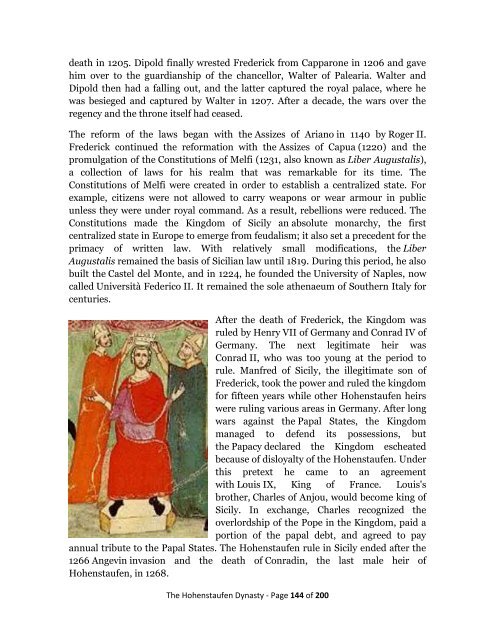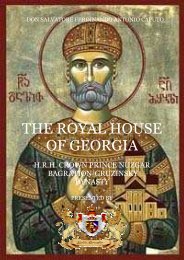here - Nobility Associations
here - Nobility Associations
here - Nobility Associations
Create successful ePaper yourself
Turn your PDF publications into a flip-book with our unique Google optimized e-Paper software.
death in 1205. Dipold finally wrested Frederick from Capparone in 1206 and gave<br />
him over to the guardianship of the chancellor, Walter of Palearia. Walter and<br />
Dipold then had a falling out, and the latter captured the royal palace, w<strong>here</strong> he<br />
was besieged and captured by Walter in 1207. After a decade, the wars over the<br />
regency and the throne itself had ceased.<br />
The reform of the laws began with the Assizes of Ariano in 1140 by Roger II.<br />
Frederick continued the reformation with the Assizes of Capua (1220) and the<br />
promulgation of the Constitutions of Melfi (1231, also known as Liber Augustalis),<br />
a collection of laws for his realm that was remarkable for its time. The<br />
Constitutions of Melfi were created in order to establish a centralized state. For<br />
example, citizens were not allowed to carry weapons or wear armour in public<br />
unless they were under royal command. As a result, rebellions were reduced. The<br />
Constitutions made the Kingdom of Sicily an absolute monarchy, the first<br />
centralized state in Europe to emerge from feudalism; it also set a precedent for the<br />
primacy of written law. With relatively small modifications, the Liber<br />
Augustalis remained the basis of Sicilian law until 1819. During this period, he also<br />
built the Castel del Monte, and in 1224, he founded the University of Naples, now<br />
called Università Federico II. It remained the sole athenaeum of Southern Italy for<br />
centuries.<br />
After the death of Frederick, the Kingdom was<br />
ruled by Henry VII of Germany and Conrad IV of<br />
Germany. The next legitimate heir was<br />
Conrad II, who was too young at the period to<br />
rule. Manfred of Sicily, the illegitimate son of<br />
Frederick, took the power and ruled the kingdom<br />
for fifteen years while other Hohenstaufen heirs<br />
were ruling various areas in Germany. After long<br />
wars against the Papal States, the Kingdom<br />
managed to defend its possessions, but<br />
the Papacy declared the Kingdom escheated<br />
because of disloyalty of the Hohenstaufen. Under<br />
this pretext he came to an agreement<br />
with Louis IX, King of France. Louis's<br />
brother, Charles of Anjou, would become king of<br />
Sicily. In exchange, Charles recognized the<br />
overlordship of the Pope in the Kingdom, paid a<br />
portion of the papal debt, and agreed to pay<br />
annual tribute to the Papal States. The Hohenstaufen rule in Sicily ended after the<br />
1266 Angevin invasion and the death of Conradin, the last male heir of<br />
Hohenstaufen, in 1268.<br />
The Hohenstaufen Dynasty - Page 144 of 200



